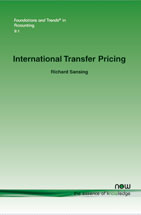International Transfer Pricing
Richard Sansing, Tuck School of Business at Dartmouth, USA AND CentER, Tilburg University, The Netherlands, richard.c.sansing@tuck.dartmouth.eduAbstract
International transfer pricing determines how the worldwide income of a multinational enterprise is divided among countries for income tax purposes when transactions occur within the firm. This review examines economics, accounting, legal research, and tax practitioner literatures on international transfer pricing.
The empirical literature documents the ability of multinational enterprises to shift income attributable to intangible assets and organizational capital from high-tax to low-tax countries. The theoretical literature reflects many different perspectives, but a recurring theme is that the current system that evolved in a world in which value was created by tangible assets with clear physical locations is not well suited for a world in which value is created by firms that develop intangible assets and choose organizational structures that economize on transaction costs.
International Transfer Pricing
Taxable income for a multinational enterprise (MNE) is determined on the basis of separate accounting where the incomes of a U.S. parent and its foreign subsidiaries are determined separately. When goods or services are transferred between related entities the transfer price – the price at which the good or service is transferred – determines how the income of the two entities is divided between the U.S. and the foreign country for income tax purposes. The rapid increase in globalization has increased both trade and foreign direct investment. Much of the increase has been in the form of intrafirm trade with the result that transfer pricing has become much more important over time.
International Transfer Pricing reviews this important literature, emphasizing the accounting and tax practitioner literatures while incorporating the most important contributions from the economics and legal research literatures. After a brief introduction, the author briefly summarizes the development of the international tax regime from the post-World War I era through the most recent revision in the U.S. transfer pricing regulations with particular emphasis on the areas of disagreement between the U.S. Treasury Regulations and the OECD Guidelines. Section 3 summarizes the empirical evidence that shows that firms successfully shift income from high-tax to low-tax countries. Section 4 examines some fundamental transfer pricing issues. Section 5 reviews the literature in which the transfer price is viewed as an optimal choice of the MNE. Section 6 examines the issue of transfer pricing through the lens of transaction cost economics, where firms vertically integrate in order to economize on transaction costs. Section 7 addresses the issue of tax compliance. Section 8 describes formulary apportionment with particular emphasis on the destination sales formulary apportionment system, and describes the advantage and disadvantages of formulary apportionment compared to separate accounting. Section 9 offers thoughts regarding promising unexplored research questions.
